Family : Aulostomidae

Text © Giuseppe Mazza

English translation by Mario Beltramini
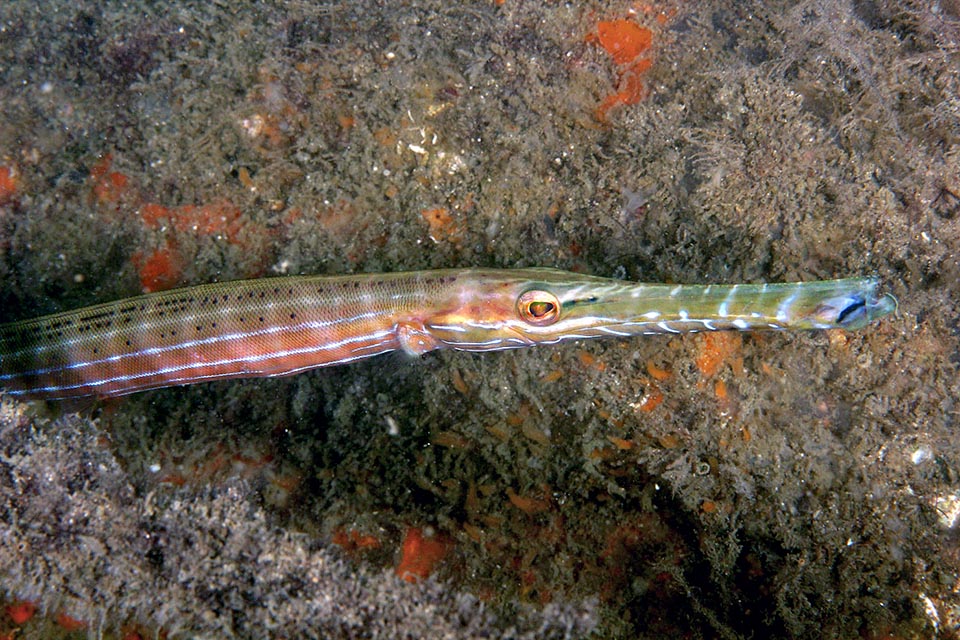
Not evident at first sight, but the ravenous West Atlantic trumpetfish, even 90 cm long, is related to seahorses because of the tubular structure of the snout © Kevin Bryant
The unusual Trumpetfish of the Caribbean (Aulostomus maculatus Valenciennes, 1841) belongs to the class of the Actinopterygii, the ray-finned fishes, to the order Syngnathiformes, the order of the needlefish and of the seahorses, and to the family of the Aulostomidae, which counts only one genus and three species present in the tropical waters of the Atlantic Ocean and of the Indo-Pacific.
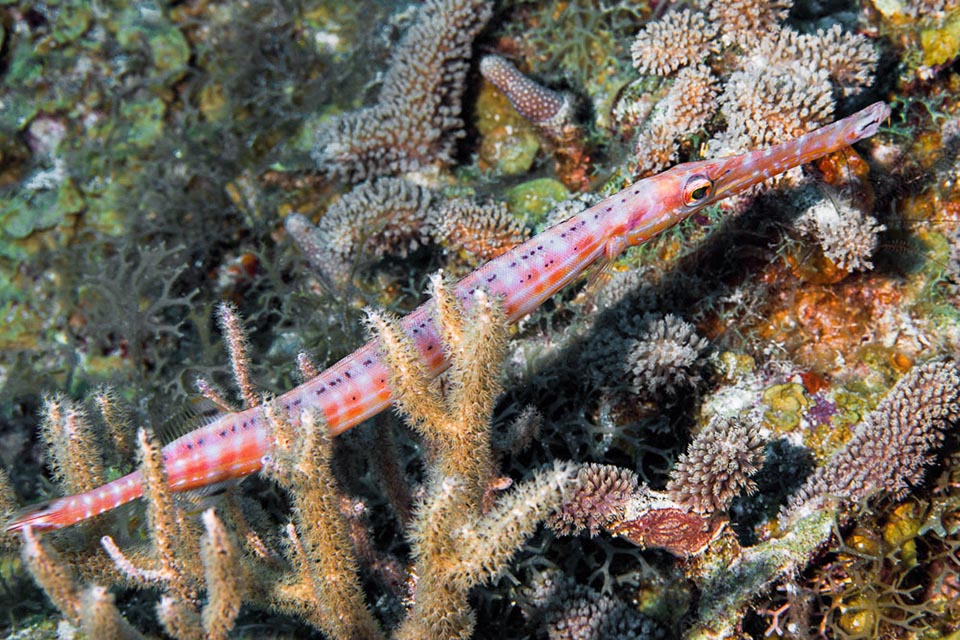
At home in the Caribbean Gulf is present starting from the Bermudas, along the Central American coasts to Brazil and the Saint Peter and Paul Rocks © François Libert
The name of the genus comes from the Greek “aulos” = flute and “stoma” = mouth, because its shape recalls the well known musical instrument.
The name of the species “maculates” = spotted in Latin, refers to the usually black small spots, but even white, present at times in various parts of its body.
Zoogeography
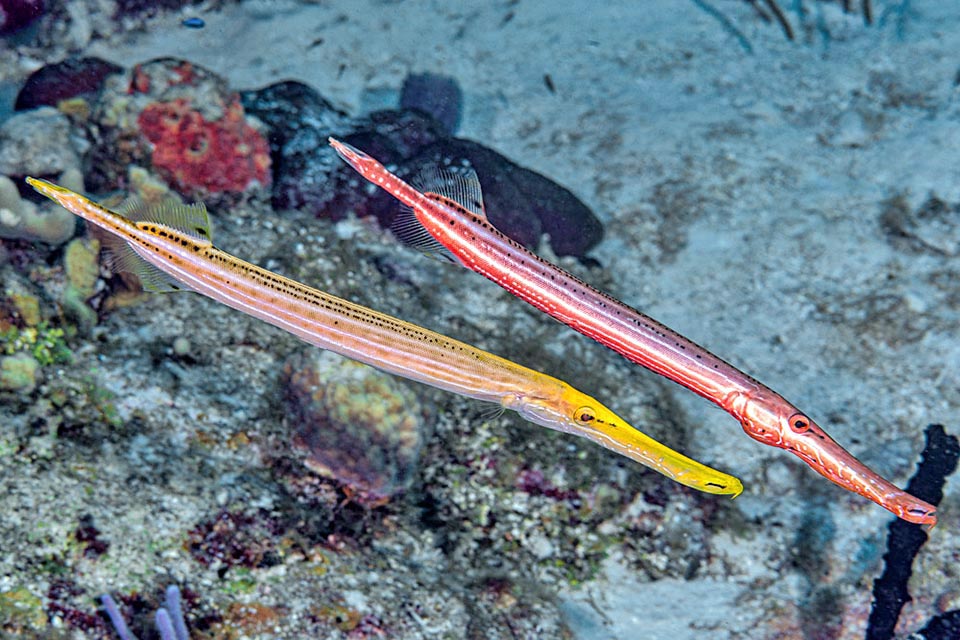
Usually characterized by small black dots on the back and pale lines on the sides, can make them disappear and instantly take various colours © François Libert
The trumpetfish of the Caribbean, as its name suggests, is at home in the Caribbean Gulf, but not only there. Indicatively, we find it in the southern USA, in Mexico, Belize, Guatemala, Honduras, Nicaragua, Costa Rica, Panama, Colombia, Venezuela, Guyana, Surinam, French Guyana and Brazil, not to forget a multitude of islands, such as the Bahamas, Cuba, Hispaniola, Jamaica, Puerto Rico, Anguilla, St. Kitts and Nevis, Antigua and Barbuda, Guadeloupe, Dominica, Martinique, St. Lucia, St. Vincent, Barbados, Grenada and Trinidad.
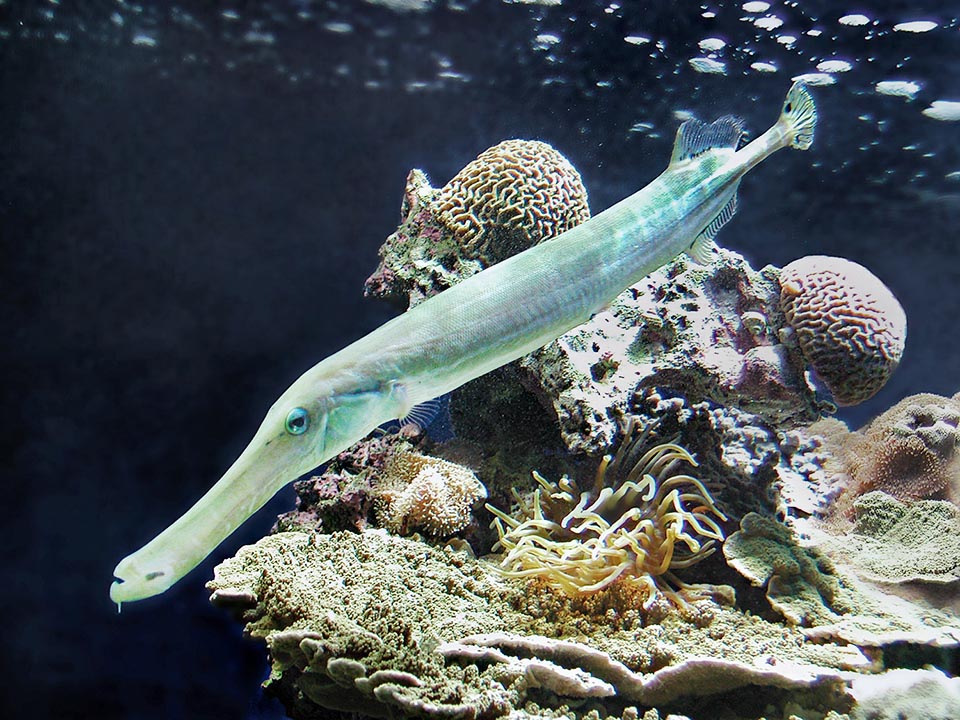
The big mouth is protractile and the very dilatable stomach may contain even big preys © Giuseppe Mazza
It seems that it has been found also at the Canary and Cape Verde islands, on the other side of the Atlantic.
Ecologia-Habitat
Master of camouflage, like Aulostomus chinensis, it is often found bent or upside down, almost invisible among the madrepores, the gorgonians and the black corals, in relatively shallow waters, up to 25 m of depth.
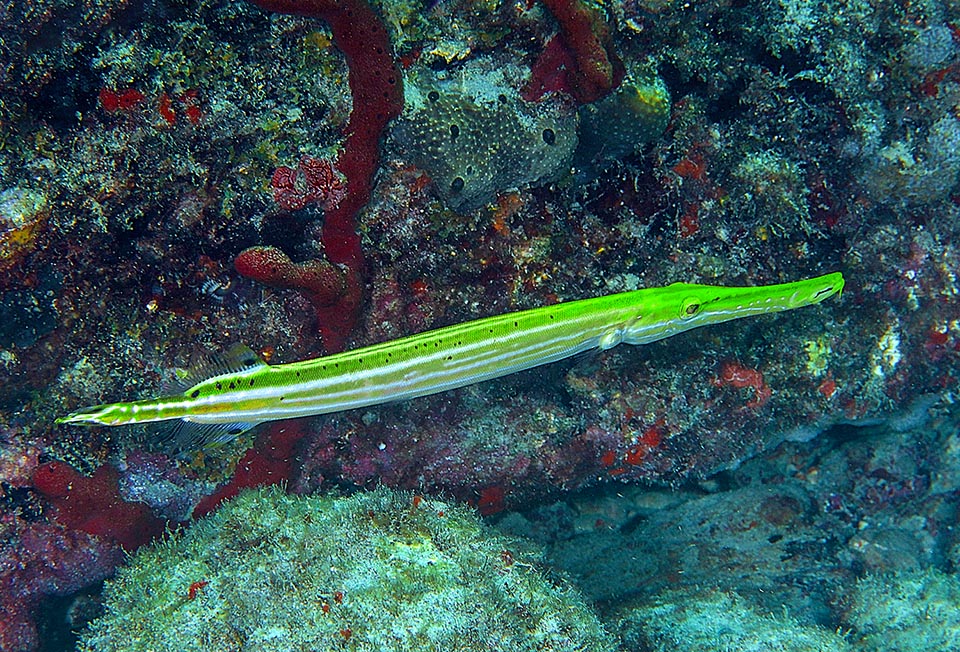
It swims in relatively shallow waters up to about 25 m of depth adapting to the colour of the seabed to catch unaware fishes and crustaceans © Kevin Bryant
Morpho-physiology
The body, elongated and thin, may exceed the 90 cm. A good part belongs to the snout, shaped like a trumpet, due to the long merged jaws, with protractile mouth carrying below a barbel.
The dorsal fin is formed by 8-13 well separate spiny rays, which rises only in case of danger, and of an unarmed part, lagging well behind, with 21-25 rays, like the anal one, identical and symmetric.
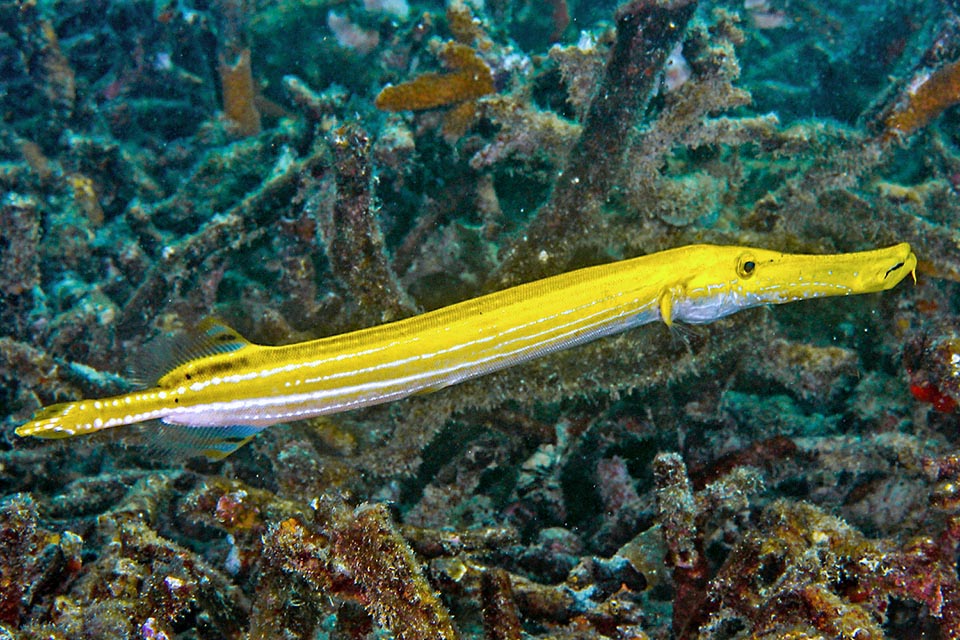
The dorsal fin is formed by 8-13 well separated spiny rays, that it raises in case of danger, and by an unarmed part, very backward, symmetrical to anal fin © Kevin Bryant
The modest ventral fins are near the middle of the body and the caudal is more or less rounded. The livery is extremely variable. Usually, it is brown-reddish with white lines and black small spots, but it may also have some dark or white horizontal stripes, continuous or broken, and vertical bands more or less marked, almost invisible at times, on a silvery, yellow or blue-greenish background, not to talk about the work done by the chromatophores with unbelievable instantaneous adaptations.
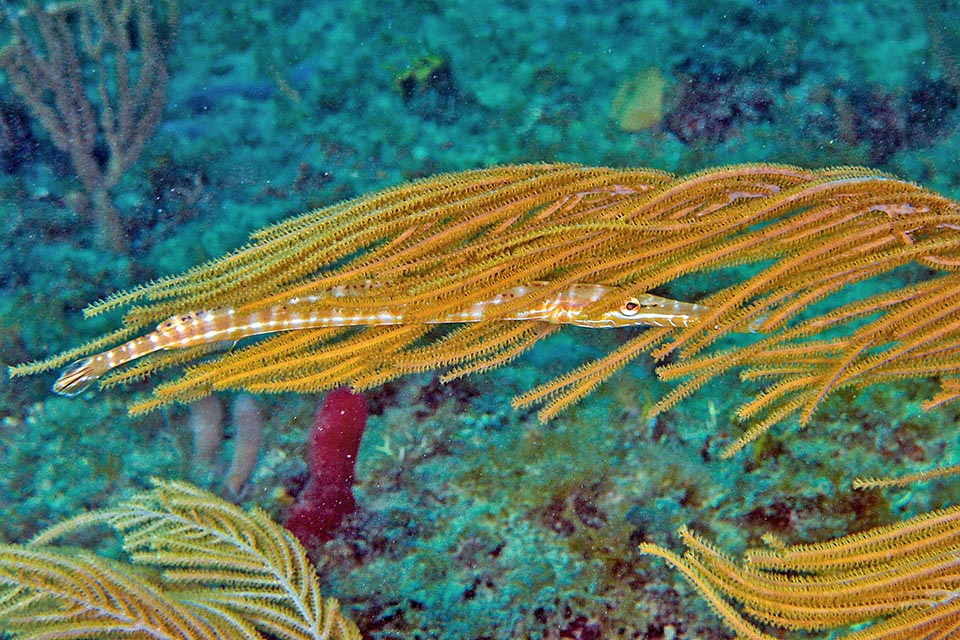
Great opportunist hunts in ambush, at times hidden, imitating like in this case the floating ramifications of the soft corals © Kevin Bryant
Ethology-Reproductive Biology
It mainly nourishes of fishes, but also of shrimps and small benthic animals.
It sucks them on the bottom or among the corals with its mouth wide as the body, and if the prey is slightly bigger, no problem, because it can even dilate and there is always room in its elastic abdomen.
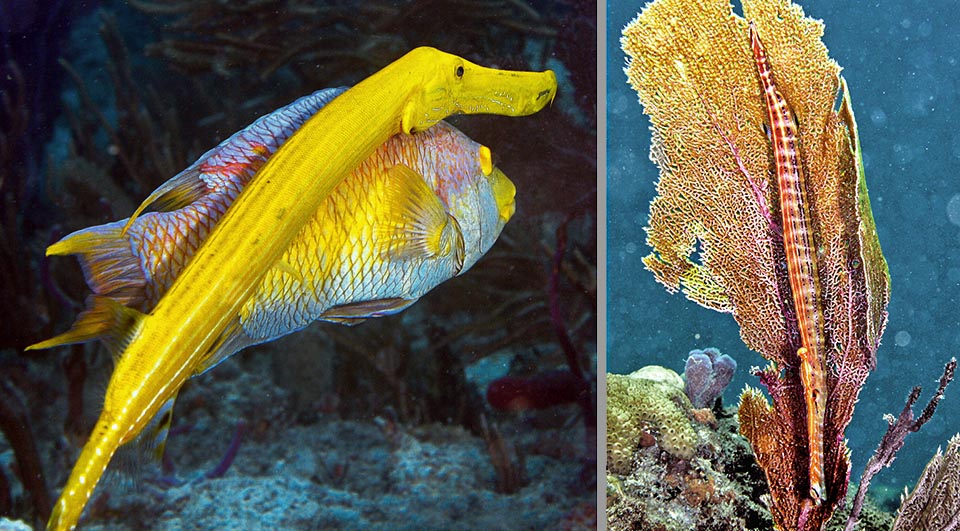
But it can hide also swimming close to peaceful fishes, like this big Bodianus rufus, or awaiting upside down the unfortunate behind a gorgonia © Kevin Bryant
In conclusion, it is an aspirator of the sea, decidedly smart and ruthless.
It follows the fishes that rummage the bottom, like the mullets, for stealing them the food from their mouth, and often swims hiding, almost stuck, on the side of the big herbivorous fishes, in order not to be sighted and to swoop as a lightning on the preys. Or it lazily keeps on the vertical among the corals, recreating their drawings and colour, ready to dive like a bolt on the passing unfortunates.
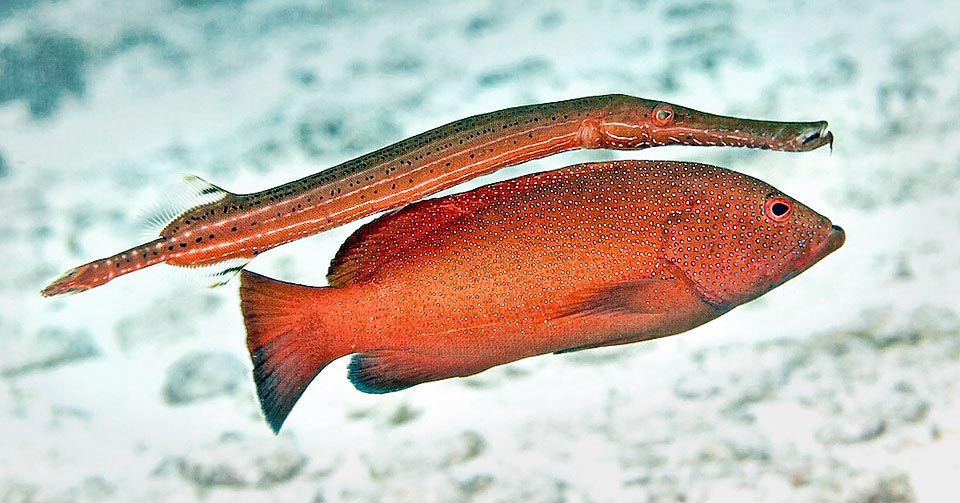
Another trick consists in joining fierce hunters, like this grouper, imitating its livery and then swoop down treacherously on the fleeing small fishes disoriented by marauder © Allison & Carlos Estape
The fertilized eggs travel freely with the currents, as do the larvae, until they get to the bottom once fully mature.
The species, common in certain zones, however overall shows a certain fragility, with a high fishing vulnerability index which marks 60 on a scale of 100.
→ For general information about FISH please click here.
→ For general information about BONY FISH please click here
→ For general information about CARTILAGINOUS FISH please click here.
→ To appreciate the BIODIVERSITY of BONY FISH please click here.
→ To appreciate the BIODIVERSITY of CARTILAGINOUS FISH please click here.
